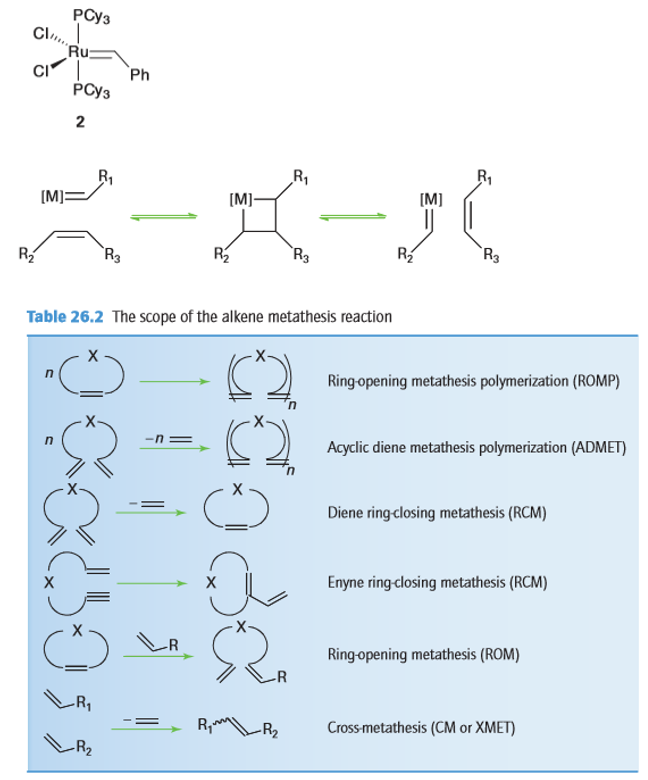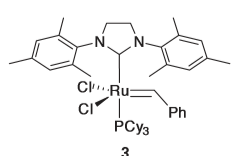
Alkene metathesis
 المؤلف:
Peter Atkins, Tina Overton, Jonathan Rourke, Mark Weller, and Fraser Armstrong
المؤلف:
Peter Atkins, Tina Overton, Jonathan Rourke, Mark Weller, and Fraser Armstrong
 المصدر:
Shriver and Atkins Inorganic Chemistry ,5th E
المصدر:
Shriver and Atkins Inorganic Chemistry ,5th E
 الجزء والصفحة:
ص695-696
الجزء والصفحة:
ص695-696
 2025-10-16
2025-10-16
 350
350
Alkene metathesis
Key points: Alkene metathesis reactions are catalysed by homogeneous organometallic complexes that allow considerable control over product distribution; a key step in the reaction mechanism is the dissociation of a ligand from a metal centre to allow an alkene to coordinate. In an alkene metathesis reaction carbon–carbon double bonds are redistributed, as in the cross metathesis reaction:

Alkene metathesis was first reported in the 1950s with poorly defined mixtures of reagents, such as WCl6/Bu4Sn and MoO3/SiO2, being used to bring about a number of different reactions (Table 26.2). In recent years, a number of newer catalysts have been introduced, and the development of the well-defined ruthenium alkylidene compound (2) by Grubbs in 1992, now known as Grubbs’ catalyst, was of seminal importance.2 Alkene metathesis reactions proceed through a metallacyclobutane intermediate:

In the case of Grubbs’ catalyst, it is known that the dissociation of a PCy3 ligand from the Ru metal centre is crucial in allowing the alkene molecule to coordinate prior to metallacyclobutane formation. The identification of this mechanism led Grubbs to replace one of the PCy3 ligands with a bis(mesityl) N-heterocyclic carbene (NHC) ligand, reasoning that the stronger σ-donor and poorer π-acceptor ability of the NHC ligand would both encourage PCy3 dissociation and stabilize the alkene complex. In a triumph of rational design, the so-called second-generation Grubbs’ catalyst (3) proved to be more active than the original bisphosphine complex. The second-generation Grubbs’ catalyst is active in the presence of a large number of different functional groups on substrates and can be used in many solvent systems. It is commercially available and has been widely used, including in the total synthesis of a number of natural products. The driving force for alkene metathesis reactions varies. For ROM and ROMP (see Table 26.2) it is the release of ring strain from a strained starting material that provides the energy to drive the reaction. For metathesis reactions that result in the generation of ethene (such as RCM or CM) it is the removal of the liberated ethene that can be used to encourage the formation of the desired products. Where there is no clearly identifiable thermodynamically favourable product possible, mixtures of alkenes result, with their relative proportions being determined by the statistical likelihood of their formation.

 الاكثر قراءة في مواضيع عامة في الكيمياء العضوية
الاكثر قراءة في مواضيع عامة في الكيمياء العضوية
 اخر الاخبار
اخر الاخبار
اخبار العتبة العباسية المقدسة


